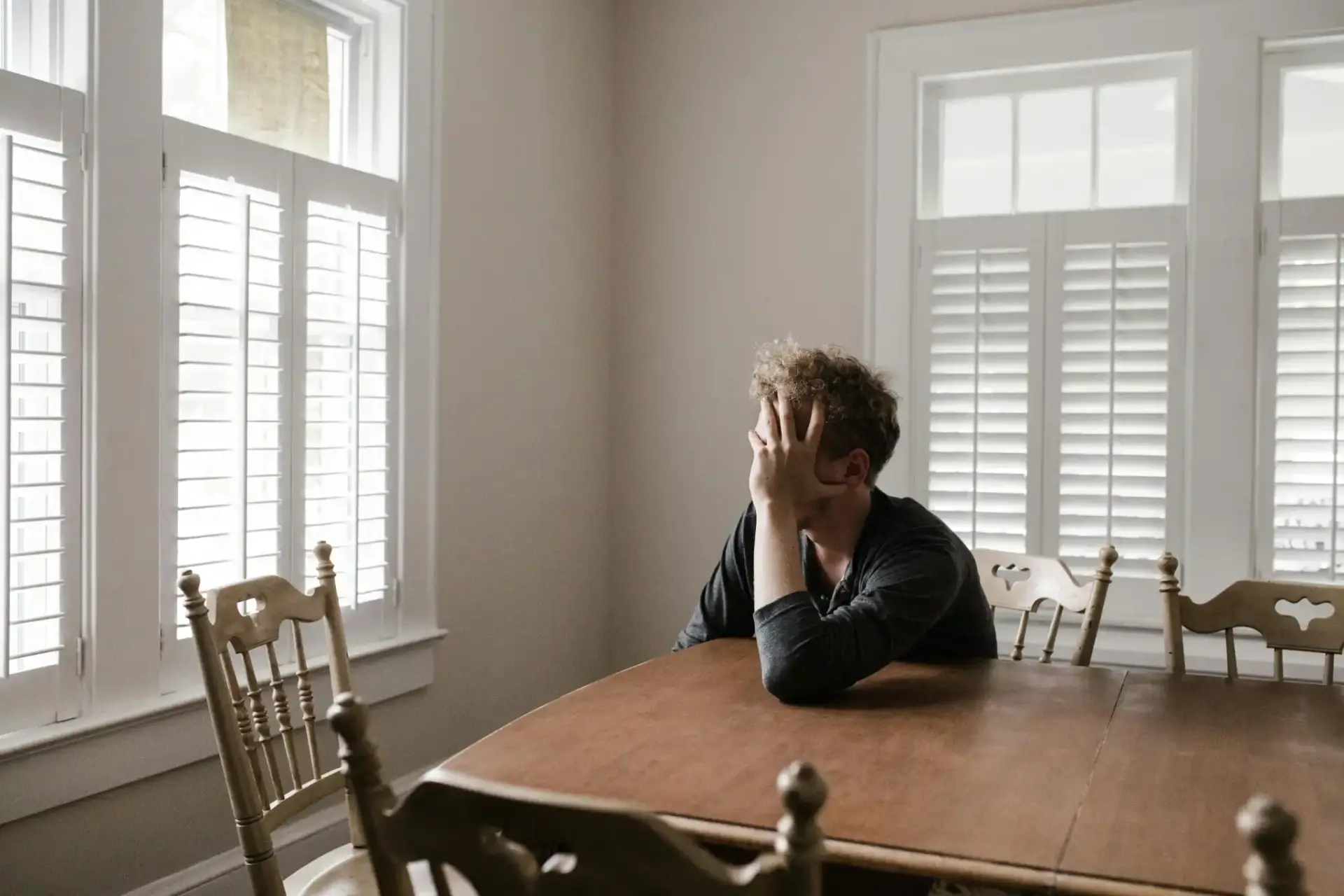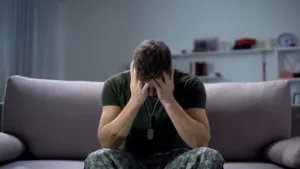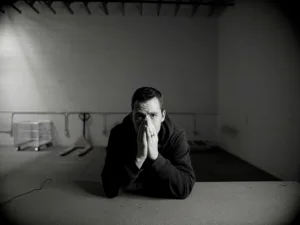When you think of post-traumatic stress disorder (PTSD), you might picture combat veterans or survivors of physical violence.
But here’s what research tells us: your brain processes emotional attacks—constant criticism, manipulation, control, or neglect—as real threats, just like physical ones.
For many men and boys, these invisible wounds can be just as devastating, even without a single physical scar.
What makes emotional abuse particularly insidious is how it often begins early in life.
Emotional abuse in childhood can leave deep, lasting scars. Research shows that the effects of early emotional trauma can persist well into adulthood, shaping self-esteem, relationships, and even physical health.
For men particularly, this reality often goes unrecognized.
Studies indicate that one in seven men will experience emotional abuse in their lifetime, yet many never speak about their experiences. In fact, 58.9% of men reaching out for help report never having told anyone about their abuse before.
Prolonged exposure to emotional abuse, whether in childhood or adult relationships, can lead to Complex PTSD (C-PTSD).
So, how does emotional abuse shape PTSD, and what steps can men take to reclaim their sense of self?
Let’s explore.
The Silent Impact of PTSD & Emotional Abuse
Emotional trauma leaves measurable changes in the brain, similar to physical injuries.
Studies show that the brain’s threat-response centers – particularly the amygdala, hippocampus, and prefrontal cortex – can be significantly affected by emotional abuse.
These changes aren’t just theoretical; they have real implications for how men process and respond to their experiences.
When emotional abuse occurs during childhood, the impact can be particularly profound.
Studies show that 14% to 43% of boys experience at least one trauma, with 1% to 6% developing PTSD.
Factors like the severity of the trauma, parental response, and repeated exposure can amplify the impact.
The developing brain is especially vulnerable during this time, as trauma disrupts neural pathways that regulate:
- Memory processing and emotional regulation
- Threat detection and response systems
- Decision-making and impulse control
These biological and developmental impacts help explain why emotional abuse creates such deep and lasting effects.
How Genetics Interact with Trauma
Your response to emotional abuse isn’t just about the experiences themselves – your genetic makeup plays a significant role, too.
Groundbreaking research involving over 200,000 people has shown that genetics accounts for 5% to 20% of PTSD risk following trauma, similar to other mental health conditions like depression.
Think of it like this: your genes create a blueprint for how your brain and body respond to trauma.
This isn’t about a single “PTSD gene” – it’s about thousands of genetic variants working together.
Some men might be more susceptible to developing PTSD after emotional abuse, while others might process similar experiences differently.
When emotional abuse occurs, several factors interact:
- Your genetic predisposition influences how your brain processes the trauma
- The stress from abuse can change how your genes express themselves
- Your biological response patterns combine with your experiences to shape your healing journey
Understanding this genetic component isn’t about finding excuses – it’s about recognizing that your reactions have a biological basis.
Just as your genes influence how you respond to trauma, they’re also part of your capacity for healing.
With the proper support and treatment, you can work with, not against, your biological patterns to recover.
Understanding your trauma is the first step. Taking action is the next.
What Counts as Emotional Abuse in Men’s Lives?
Emotional abuse often operates in the shadows, making it challenging to identify and address.
While studies show that only about 38% of male abuse survivors disclose their experiences, this silence often reflects a lack of therapy designed with men in mind—not a lack of willingness to heal.
Men deserve a therapeutic environment that is welcoming, speaks their language, and understands their experiences.
Rather than expecting men to adapt to therapy, we believe in providing support that resonates with how men naturally process and deal with emotional challenges.
Forms of Emotional Abuse
Emotional abuse manifests in various forms, each leaving its own distinct impact:
Manipulation and Control: This includes using shame or guilt to undermine a man’s sense of self-worth. Examples might include:
- Weaponizing traditional masculine expectations (“You’re not man enough”).
- Making unilateral decisions in relationships to assert dominance.
- Using phrases like “boys/men don’t cry” or “You’re being too sensitive” to silence emotions.
Gaslighting and Reality Distortion: This happens when someone manipulates you into doubting your own perceptions and memories. For men, this can intersect with cultural expectations about toughness:
- Being told you’re “imagining things” when you express hurt.
- Having experiences dismissed as “oversensitivity” leads to self-doubt and emotional disconnection.
When these patterns begin in childhood, their impact can be particularly severe.
Research indicates that children who experience emotional abuse are more likely to develop complex trauma responses later in life.
For boys, this might include:
- Having emotions consistently dismissed or punished (“Stop crying, be tough!”).
- Being held to impossible standards of “toughness.”
- Messages that they are never enough or less than.
- Experiencing emotional neglect disguised as “building character.”
- Witnessing family violence while being expected to “be strong.”
Social isolation often accompanies emotional abuse, whether in childhood or adult relationships. This might involve:
- Monitoring communications and relationships
- Using guilt to limit contact with friends and family
- Controlling access to support systems
- Making you feel responsible for the abuser’s emotions
Understanding these patterns is important because they often feel “normal” to those experiencing them, especially if they began in childhood.
Recognition is the first step toward healing, and acknowledging these experiences as abuse doesn’t make you weak—it takes considerable strength to face these truths.
How Emotional Abuse Leads to PTSD & C-PTSD
Understanding how emotional abuse affects mental health isn’t always simple.
As mentioned, our brains process emotional threats as real dangers – activating the same survival responses as physical threats.
These responses aren’t signs of weakness; they’re your brain doing exactly what it’s designed to do: protect you.
Emotional abuse can lead to two distinct but related trauma responses: PTSD and Complex PTSD (C-PTSD).
While PTSD can develop from either single or multiple traumatic experiences, C-PTSD specifically emerges from prolonged exposure to emotional abuse or trauma, especially during developmental years.
Think of PTSD as your brain’s response to trauma and C-PTSD as what happens when that trauma is repeated or sustained over time.
Here are the key factors that influence their development:
Prolonged Exposure
Chronic emotional abuse keeps your brain on high alert, constantly scanning for threats and trying to predict the next attack. This prolonged stress response rewires neural pathways, making it increasingly difficult to feel safe—even in non-threatening situations.
Over time, this persistent state of hypervigilance affects personality development, emotional regulation, and self-identity.
Such long-term effects are a defining feature of Complex PTSD, which often arises from the ongoing nature of trauma rather than isolated incidents.
Early-Life Relationship Trauma
The impact of childhood emotional abuse runs deep. Studies show up to 43% of boys experience at least one trauma during their formative years.
While single traumatic events may lead to PTSD, prolonged childhood emotional abuse often results in C-PTSD due to its occurrence during critical developmental periods.
Previous Trauma History
Each traumatic experience can compound the effects on others.
This is especially true for men who experienced childhood emotional abuse and later face similar patterns in adult relationships.
- Single traumatic events typically contribute to PTSD
- Multiple traumas or ongoing abuse patterns often lead to C-PTSD
The brain becomes increasingly sensitive to perceived threats, making it harder to distinguish between past trauma and present reality.
Attachment and Relationship Patterns
Early relationships with caregivers shape our understanding of emotional safety. When these relationships involve abuse:
- Acute betrayals or violations might lead to PTSD
- Chronic emotional abuse during developmental years typically results in C-PTSD
- Disrupted attachment patterns affect both conditions but are a core feature of C-PTSD
Understanding these distinctions helps explain why some men develop PTSD while others develop C-PTSD. Neither PTSD nor C-PTSD means you’re “damaged.”
These are normal responses to abnormal situations.
Recognizing these patterns is often the first step toward understanding your experiences and choosing the most effective treatment approach.
There’s more to male trauma than what society tells you.
Download our no-BS guide to understanding male depression – it’s free!
Recognizing Signs & Symptoms of PTSD from Emotional Abuse
When PTSD develops from emotional abuse, recognizing its signs can be challenging, especially in this digital age where mental health content is everywhere.
While social media has helped destigmatize mental health conversations, they can’t replace the expertise of licensed professionals.
Misdiagnosing PTSD from emotional abuse or inadequate advice can delay proper treatment, making it crucial to consult a mental health expert.
For men, recognizing these signs is even more challenging.
These symptoms might be dismissed or masked behind what others see as “typical male behavior” – like withdrawing as “being strong and silent” or anger as “just being a guy.”
This dismissal can be particularly dangerous in an era of online self-diagnosis and viral mental health content.
Let’s explore these symptoms through a professional lens:
Physical and Body-Based Symptoms
Your body keeps score of emotional trauma, often expressing it through physical symptoms. Trauma can significantly impact our nervous system, leading to:
- Chronic muscle tension and unexplained pain
- Sleep disturbances, including insomnia and trauma-related nightmares
- Digestive problems that seem to have no physical cause
- Physical stress responses like a racing heart, sweating, and trembling
- Fatigue and reduced immune function
- Hyperarousal – feeling constantly “wired” or unable to relax
These physical manifestations aren’t “all in your head” – studies show that emotional trauma creates real, measurable changes in brain and body function.
Emotional and Psychological Impact
The emotional aftermath of abuse often runs deeper than many realize, often manifesting as:
- Sudden anxiety or panic attacks, especially in situations that remind you of past abuse
- Unpredictable mood changes that feel beyond your control
- Persistent difficulty trusting others or forming close relationships
- Heightened startle response – feeling constantly “on guard”
- Emotional numbness or disconnection from feelings
- Intrusive memories or flashbacks of abusive situations
- Difficulty expressing emotions or needs
- Shame, low self-esteem, and self-blame
- Questions about your own reality (result of gaslighting)
For men, these emotional symptoms can be particularly challenging to acknowledge. Society often expects men to “tough it out” or “get over it,” making it harder to recognize these responses as valid signs of trauma.
Changes in Daily Functioning
PTSD from emotional abuse typically affects multiple areas of life:
- Work performance might suffer due to concentration difficulties and memory problems
- Relationships may become strained as trust issues and fear of vulnerability surface
- Social withdrawal might increase as you try to avoid potential triggers
- Development of avoidance behaviors around certain places, people, or situations
- Changes in self-care habits or daily routines
- Difficulty making decisions or planning for the future
- Increased use of alcohol or other substances to cope
These changes aren’t character flaws or signs of weakness—they’re your brain’s natural responses to trauma, backed by neuroscience research.
Recognizing this can be the first step toward healing.
However, the complexity of these symptoms makes professional evaluation crucial.
In an age where mental health advice is increasingly available on social media platforms, it’s essential to understand the risks of self-diagnosis and why TikTok shouldn’t be your therapist.
While social media might offer relatable content about mental health, studies show that 91% of mental health content creators aren’t qualified professionals.
What appears to be PTSD might be another condition entirely, requiring different treatment approaches.
A licensed mental health professional can:
- Consider your unique history and context
- Provide accurate, evidence-based assessment
- Develop personalized treatment strategies
- Monitor and adjust your healing journey as needed
Many men find relief in knowing their experiences have a name and that their reactions make sense.
If you recognize these patterns in yourself, you’re not alone, and qualified help is available.
Additional Signs Specific to C-PTSD
While PTSD and C-PTSD share many symptoms, C-PTSD includes additional challenges that develop from prolonged trauma:
Difficulties with Emotional Regulation |
|
Changes in Self-Perception |
|
Relationship Challenges |
|
Changes in Belief Systems |
|
These additional symptoms often require specific therapeutic approaches beyond standard PTSD treatment.
Both conditions benefit from professional support, but understanding these distinctions helps guide the most effective treatment path.
Evidence-Based Treatment Approaches
Healing from PTSD caused by emotional abuse often requires professional treatment. Modern trauma therapy offers several evidence-based approaches, each addressing different aspects of trauma recovery.
Here are some options to consider:
1. EMDR (Eye Movement Desensitization and Reprocessing) Therapy
EMDR is a specialized approach that helps the brain reprocess traumatic memories. Research shows it’s particularly effective for PTSD, especially when the trauma involves emotional abuse.
During sessions with a certified EMDR therapist, you’ll work to:
- Process traumatic memories in a safe, supportive environment
- Reduce the intensity of emotional triggers
- Develop new, healthier ways of relating to past experiences
2. Cognitive Processing Therapy
This structured approach helps you understand how trauma has affected your thoughts and beliefs. Working with a trauma-informed therapist, you can address:
- Self-blame and guilt
- Trust issues stemming from abuse
- Distorted beliefs about safety and relationships
- Patterns of negative self-talk
3. Group Therapy for Men
Many men find unique healing in male-specific group therapy settings. Sharing experiences with others who understand can:
- Reduce isolation and shame
- Provide peer support and validation
- Offer practical coping strategies from others’ experiences
- Create a sense of community and belonging
4. Advanced Treatment Options
For some men, traditional therapy approaches might need supplementation with innovative treatments. Ketamine-assisted psychotherapy, when provided by qualified professionals, has shown promising results for treatment-resistant PTSD and depression.
The Importance of Male-Focused, Trauma-Informed Care
Working with therapists who expressly understand men’s experiences with trauma ensures that your treatment:
- Recognizes the unique ways trauma affects men
- Understand male-specific paths for recovery
- Responds to your individual needs and experiences
- Actively avoids re-traumatization
- Creates a comfortable, judgment-free environment
Remember, healing isn’t linear, and what works best varies from person to person.
Denver Men’s Therapy licensed therapists, with advanced training in trauma treatment, can help determine which approach or combination of approaches might work best for your specific situation.
Breaking free from emotional abuse starts with being heard. Reach out to DMT’s male-focused therapy team for support and understanding.
Building Your Recovery Toolkit: Steps to Heal from PTSD
Recognizing when to seek professional support is often the first and most crucial step in healing from PTSD.
While acknowledging trauma takes courage, recognizing that you need support shows wisdom—not weakness.
The Power of Early Intervention and Self-Education
Early intervention can significantly impact recovery outcomes. However, it’s essential to:
- Seek information from reliable, professional sources.
- Understand your symptoms through validated research
- Learn about trauma responses from qualified professionals
- Recognize that healing requires both understanding and action
Creating Safety and Stability in Daily Life
Recovery starts with establishing a foundation of safety in your daily routine. This might involve:
- Identifying and minimizing exposure to triggers when possible
- Creating predictable daily routines
- Establishing safe spaces for processing emotions
- Building consistent sleep and self-care practices
Developing Healthy Coping Mechanisms
Working with a trauma-informed therapist can help you develop effective coping strategies:
- Grounding techniques for managing flashbacks
- Mindfulness practices for anxiety reduction
- Stress management tools
- Healthy emotional expression methods
Recovery often involves rebuilding what emotional abuse has torn down. For many men, combining trauma treatment with self-esteem therapy helps restore their sense of self-worth and personal identity.
Setting and Maintaining Boundaries
Establishing boundaries is a vital part of reclaiming your well-being. Recovery may involve:
- Identifying your personal limits
- Communicating needs clearly
- Recognizing unhealthy relationship patterns
- Maintaining consistent boundaries with others
Building Reliable Support Networks
Recovery doesn’t happen in isolation. Building a strong support system helps you feel less isolated and more connected. Key resources include:
- Professional support from qualified therapists
- Trusted friends and family members
- Support groups with others who understand
- Community resources and organizations
These tools and strategies aren’t just coping mechanisms but investments in your future well-being. Each small step in building your recovery toolkit strengthens your foundation for healing.
While the path forward might seem overwhelming now, remember that thousands of men have walked this path before you, and professional support is available when you’re ready to take that first step.
Your Path to Healing: Taking the First Step
Making the decision to seek help is often the most challenging part of the journey.
For many men, years might pass between recognizing something isn’t right and reaching out for support. You don’t have to wait that long.
Finding Appropriate Support
Choosing the right therapist can make all the difference in your recovery. Look for someone who:
- Has experience treating PTSD and in trauma therapy
- Specialized training in men’s mental health
- Offers an approach and communication style you feel comfortable with
- Understand practical factors like location and availability
- Understands the dynamics of emotional abuse and its effects
What to Expect from Therapy
The therapy process is designed to provide clarity and support from the very beginning. Initial steps typically include:
- A comprehensive assessment of your experiences
- Discussion of your goals and concerns
- Development of a tailored treatment plan
- Clear explanation of therapeutic approaches
- Establishment of a safe, confidential space
Available Resources
Beyond individual therapy, several resources can support your healing:
- Crisis hotlines for immediate support
- Support groups for men with similar experiences
- Educational materials about trauma and recovery
- Community mental health organizations
Need to Talk Now?
Immediate, confidential support is available 24/7:
- Colorado Crisis Services: 1-844-493-8255
National Suicide Prevention Lifeline: 988
If you’re ready to take that first step, know that Denver Men’s Therapy provides a judgment-free space where your experiences will be heard and validated. Our team of licensed therapists specializes in helping men navigate trauma and build stronger, healthier lives.
You don’t have to carry the weight of trauma alone.
Connect with DMT’s licensed therapists who specialize in men’s PTSD recovery.
FAQs
1. Can you have complex PTSD from emotional abuse?
Yes, emotional abuse is actually one of the primary causes of C-PTSD. While we’ve discussed PTSD throughout this article, C-PTSD has some distinct features, including:
- Difficulty regulating emotions
- Problems with self-perception and identity
- Struggles with maintaining relationships
- Changes in consciousness (dissociation)
- Loss of belief systems
- A profound sense of hopelessness about the world
2. Can therapy help men recover from PTSD caused by emotional abuse?
Yes, people who receive trauma-focused therapy experience significant improvement in their PTSD symptoms.
For men specifically, therapy approaches that acknowledge male experiences and societal expectations tend to show higher success rates.
Some effective therapy options include:
- EMDR (Eye Movement Desensitization and Reprocessing)
- Cognitive Processing Therapy (CPT)
- Male-specific group therapy
The key is finding a therapist who understands both trauma and men’s unique challenges in seeking help.
3. How do I support a man who is dealing with PTSD from emotional abuse?
As a friend, partner, or family member, your support can make a significant difference. Here’s how:
- Listen without trying to “fix” the situation
- Avoid phrases like “get over it” or “man up”
- Respect their pace in sharing information
- Learn about trauma responses to better understand their experiences
- Encourage professional help without pushing
- Maintain consistency in your support
4. How long does it take to recover from PTSD caused by emotional abuse?
Recovery timelines vary significantly based on the following:
- The duration and severity of abuse
- How long ago the abuse occurred
- Current life stressors and support systems
- Individual coping mechanisms
- Type and frequency of treatment
While some men notice improvement within a few months of consistent therapy, full recovery is often a longer journey.
What’s important isn’t the timeline and progress made along the way. Many men find that even minor symptom improvements can significantly impact their quality of life.









